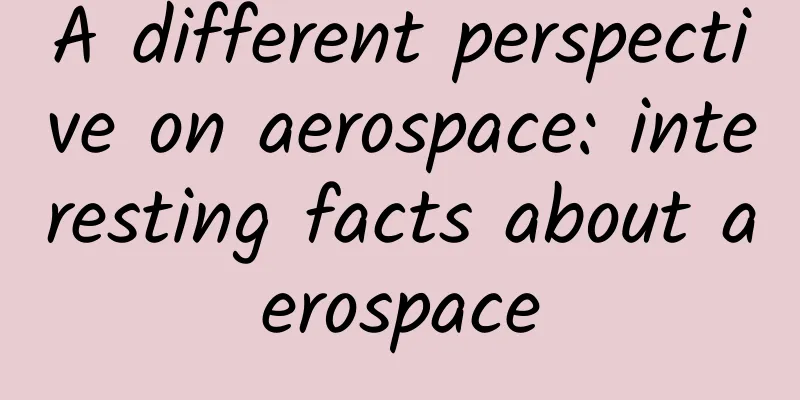A different perspective on aerospace: interesting facts about aerospace

|
The world is never short of beauty, but it lacks eyes to discover beauty. Here we will show you the "alternative beauty" of the aerospace field - aerospace trivia. 1. The First Organism in Space The first creature to enter space was not a human, but a stray dog named Laika from Moscow. On November 3, 1957, the former Soviet Union placed Laika in an artificial satellite and sent it into the Earth's orbit. Before that, humans knew little about the universe and space flight, and the former Soviet Union had not yet mastered the technology of spacecraft recovery. In other words, for Laika, this was destined to be a one-way death journey. Laika fixed to the seat of the space capsule Scientists fixed Laika to a special space capsule seat and equipped it with respiratory and heart monitors to ensure that Laika's physiological data could be transmitted back after entering space. Unfortunately, 5 to 7 hours after launch, the ground personnel no longer received Laika's physiological data. The little guy died directly due to panic and heat exhaustion, and of course his body never returned to Earth. On April 14, 1958, the satellite that Laika was riding on disintegrated in space. Laika only survived in space for less than 7 hours, but her short flight opened a new chapter for mankind's space dream. I hope that with the advancement of technology, we will no longer see any casualties of any living creatures, and such regrettable and terrifying sacrifices will never happen again. The statue of Laika 2. Astronaut with a gun Early astronauts were equipped with guns when they went into space, so why did they need guns? In fact, astronauts brought guns into space, not to defend against teammates or aliens; not to use them in space, but to use them in the case of survival on the ground. On March 19, 1965, Soviet astronaut Alexi Leonov, who had just completed the first spacewalk in human history, and his partner Pavel Belyayev returned to Earth on the Voskhod-2 spacecraft. However, due to some technical reasons, the landing location of Voskhod-2 was more than 300 kilometers off, and the two pilots were trapped in the snow-covered primitive coniferous forest. The two astronauts were not found by search and rescue personnel until two days later. These two days were extremely tormenting for them. The terrible thing was not the cold and fatigue, but the howling of wild wolves in the surrounding forests. After this incident spread, astronauts from various countries have carried guns during training, and they never leave their guns after entering space. At first, astronauts were equipped with ordinary pistols, but later with the development of technology, various countries developed a space gun specifically for astronauts. Space Gun 3. The Last Soviet There was an astronaut who was a Soviet citizen before he set off. While he was in space, his country began to disintegrate. When he returned to Earth, his country no longer existed. He was astronaut Sergei Klikalev. Cosmonaut Sergey Klikalev Klikalev first successfully entered the Mir space station in 1988 on the Soyuz TM-7 spacecraft after three years of space training. 115 days later, he completed his mission and returned to Earth smoothly. Then in 1991, the Soviet Union at that time asked him to perform another mission and sent him into space, but this time he did not expect that his country would no longer exist after he returned. When the coup occurred, Klikalev was in space for the seventh month. The powerful Soviet Union was in turmoil and disintegration. The Soviet Union split into 15 countries. At this time, Klikalev, who was in space, seemed to have been forgotten. Klikalev was told that he could not be brought back to Earth because his country no longer existed. Under such circumstances, Klikarev could only wait in space for the country's political situation to stabilize so that he could return home. Finally, on March 17, 1992, after more than 300 days in space, Klikarev returned to Earth. He was also called "the last Soviet man on Earth." Due to special reasons, Klikarev also set the record for the longest time in space under a forced situation. When Krikalev returned to Earth, his country had disappeared and the land he was on was called Russia. Krikalev then chose to become a Russian citizen and continued to carry out another space mission two years later, becoming the first Russian astronaut to ride on a NASA space shuttle. After completing six flight missions, Krikalev officially retired. With his outstanding performance in the field of aviation, this astronaut, who has the titles of "Hero of the Soviet Union" and "Hero of Russia", continues to play a role in the field of aerospace. 4. Astronaut’s nails We know that to become a qualified astronaut, one must not only master a lot of aerospace knowledge, but also have strong physical and psychological qualities, and have strong adaptability and tolerance in special environments. It is worth mentioning that there is another sad thing for astronauts, that is the nail problem; no matter how short the nails are cut, they can grow very long in a few days; and in space, if the nails are too long, they will be compressed and the whole nail will fall off, which is very painful and difficult to stop bleeding, which is an extremely dangerous thing. Therefore, astronauts must pull out the entire nail before going into space, and the wound must heal before going into space. Of course, with the development of aerospace technology, astronauts do not have to remove their nails. They still need to trim their nails very short before going into space. If they need to trim their nails in space, they must not cut them casually, otherwise the consequences will be very serious. These flying nails may cause scratches on the astronauts' skin or malfunction of the aircraft's instruments, either of which is very dangerous. Instead, they find an air circulation port and let the cut nails adhere to it, but this is very difficult to operate. Astronaut's nails 5. Domestic space suits and shrimp On September 27, 2008, with the help of Liu Boming and Jing Haipeng, Chinese astronaut Zhai Zhigang of the Shenzhou VII spacecraft successfully completed the first spacewalk while wearing the Feitian extravehicular spacesuit developed by my country. However, behind the extravehicular spacesuit were hidden unknown emotions and sorrows. Astronaut Zhai Zhigang of Shenzhou VII leaves the spacecraft The biggest difference between an extravehicular suit and an indoor suit is that the upper and lower limbs of an extravehicular suit can be moved, even the gloves. The joints must be flexible, but if the joints are flexible, they may not be sealed enough, and if the sealing is guaranteed, there may be no flexibility. This brings great difficulties to the design. After looking at countless examples abroad, the designer Li Zhi found that the corrugated structure used in their space suits relies on extrusion deformation, which requires great strength and is not easy to move. However, by chance, a large shrimp suddenly inspired the designer Li Zhi. He found that the body joints of shrimps are very special, which can ensure the flexibility of the body and make it very light to move. So Li Zhi and his colleagues bought various shrimps for observation, and finally succeeded after experiments. Since the shoulders and elbows of the space suit all use this "shrimp" structure, it is much better than similar foreign products. Thanks to the wisdom and hard work of our scientific researchers, it usually takes seven or eight years to develop an extravehicular space suit abroad, but we completed the development task in 47 months. Have these little-known facts overturned some of your perceptions of aerospace, or made you feel that aerospace is no longer so mysterious, or aroused your curiosity about the aerospace industry? There are a thousand Hamlets in the eyes of a thousand people. If you look at aerospace from a different perspective, you will also find your own most unique perspective. Zhou Hui, First Academy of Aerospace |
Recommend
618 e-commerce advertising insight report!
This year, Double 11 enters its 11th year and 618...
Want to eat medicated food to regulate your body after "Yang Kang"? Huaxi doctors: All the methods are written for you!
Yesterday, [Huaxi Doctors] made it clear about th...
Flurry: Mobile gamers spend less time playing but more money
[[147285]] Flurry, a mobile application data anal...
Be careful, eating too much of this kind of food will make you stupid! Check if you are eating it every day.
Generally speaking, people are more concerned abo...
Solve the problem that the phone cannot copy 4GB files
Reasons why you cannot copy files larger than 4GB...
WeChat nicknames can now be circled, try it now
Dan Di, who is dedicated to making WeChat fancy, ...
How does the South-to-North Water Diversion Project achieve the goal of “water flowing to higher places”?
The terrain of the East Route Project of South-to...
2022 Brand Marketing Disruptor
If the first half of 2021 belongs to new consumpt...
Product Operation: These 5 points will teach you how to do competitive product analysis!
Competitive analysis is a skill that is easy to g...
How can gaming products increase their first batch of seed customers?
When operating seed users , the operation will ha...
Aiming at Apple, LeEco aims to capture the US market
After the news that LeEco's mobile phone Sili...
Are you using the 6 types of keywords that you must promote when doing marketing?
There are 6 common types of keywords : brand word...
5 ways to attract traffic through live streaming
Business owners are also confused. We have set th...
How to conduct marketing in the Spring Festival gift-giving market? Share 6 cases!
The Spring Festival is coming soon. In fact, the ...
Are we heading for the coldest winter yet?
The first snow in the second half of 2024 seems t...









